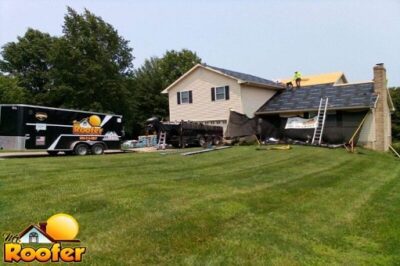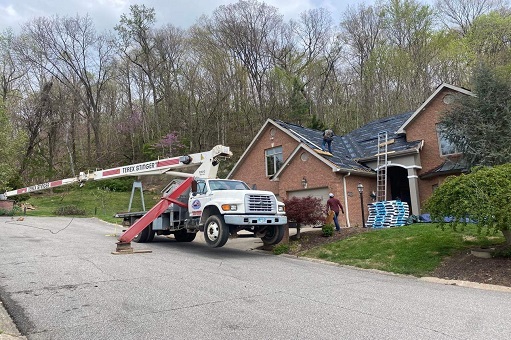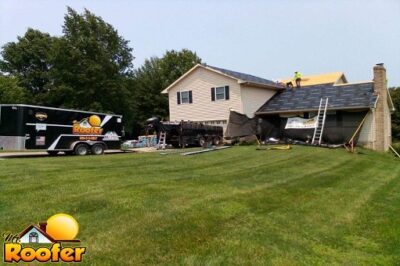Introduction to Chimney Flashing: A Critical Component for a Dry Home
Chimney flashing is what keeps the rain out where your chimney sticks through the roof. Picture it as a waterproof shield. Without it, water would slide down the chimney right into your living room. There are a couple of types: step flashing that goes along with the lines of your roof, and counter flashing that covers the step flashing and is tucked into the chimney mortar. Both are vital. Incorrectly installed or old, worn-out flashing can lead to leaks, and repairing water damage inside your home can get expensive fast. Think of chimney flashing as cheap insurance against a much bigger problem. So, ensuring it’s in good shape is key to keeping your home dry and your wallet happy.
Understanding Chimney Flashing: What Is It and How Does It Work?
Chimney flashing is your roof’s best defense against water damage. It’s the metal strip that connects your chimney to your roof, creating a watertight barrier. Without it, water can easily sneak into your home, causing leaks, mold, and structural damage. Flashing comes in two main parts: the base, or step flashing, that wraps around the chimney, and the counter flashing, which is embedded into the chimney’s mortar joints. These layers work together to block water from getting inside. When it rains, water flows down your roof, around your chimney, and safely away from your home, thanks to the flashing. Proper installation and maintenance are key. If the flashing is damaged or incorrectly installed, it’s not going to keep water out. Regular checks ensure it stays in working order, protecting your home from costly water damage.
The Importance of Chimney Flashing in Preventing Water Damage
Chimney flashing is your roof’s unsung hero in the battle against water damage. This critical component seals the gap between your chimney and roof, keeping water from sneaking into your home. Without properly installed flashing, water can easily invade, leading to mold, mildew, and structural damage that can cost a fortune to fix. Think of flashing like the shield of a warrior—without it, the fortress (your home) is vulnerable to the relentless attacks of rain and snow. The key to water-tight flashing lies in its materials—aluminum, copper, steel, or rubber—and in the hands of a skilled installer. Remember, a small investment in good chimney flashing now can save you from a massive repair bill later. Ignoring it? Well, that’s like inviting the enemy in through the front door.
Types of Chimney Flashing: Materials and Methods
Chimney flashing is your roof’s best defense against water damage. It’s like the armor that keeps rain and snow from sneaking into your home where the chimney meets the roof. There are mainly two types of materials used for flashing: metal and rubber. Metal, especially aluminum and copper, is popular because it’s durable and fits well with most roofs. Rubber, or more precisely EPDM (ethylene propylene diene monomer), is newer but valued for its flexibility and water resistance.
When it comes to methods, there are three big ones you should know. First, there’s step flashing, a series of metal pieces layered with shingles to guide water away. Then, counter flashing, which involves bending metal to cover the step flashing and gets embedded into the chimney mortar. Last is the crickets or saddle, a small, pointed ridge that redirects water away from the chimney’s base, crucial for larger chimneys.
Each has its role, and often, a combination ensures your chimney and home stay dry. So, remember, it’s not just about the material, but also how it’s applied. Your best bet is to have a pro look at what method and material suit your roof and chimney combo to keep water out for good.
Recognizing Signs of Chimney Flashing Failure
When water starts making an unwanted entrance into your home around the chimney, you’ve got a problem. Most often, this is a sign your chimney flashing is failing. Flashing is that thin metal layer ensuring the junction between your chimney and roof is watertight. But when it fails, you’re in for trouble – think leaks, water damage, and a potential hit to your wallet. Look out for these tell-tale signs: water stains on your ceiling near the chimney, peeling paint or wallpaper in the same area, and dampness or droplets in your attic around the chimney base. Seeing bits of metal in your yard could also mean the flashing is damaged or coming loose. Each symptom points to water breaching where it shouldn’t, and it’s a call to action. Getting ahead of these issues can save you from more extensive damage. It’s not just about spotting the damage but acting quickly to fix it.
The Process: How Chimney Flashing is Installed
Chimney flashing is like a waterproof jacket for where your chimney meets your roof. It stops water from sneaking into your home. Flashing involves a few steps and different materials. First, there’s the base flashing. This is a metal strip that’s installed along the bottom of the chimney where it meets the roof. It’s like laying down the first layer of defense. Next, comes the counter flashing. This part is embedded in the chimney’s mortar joints and bends down over the base flashing. It acts like a helmet on top of the first layer, making sure no water gets through. The last piece of the puzzle is the cap or cricket flashing. This diverts water away from the chimney, especially on steep roofs or in areas that get a lot of rain or snow. The whole process needs to be spot on. If it’s not, water will find a way in, causing damage to your home. It’s best to have a pro do this right once than to deal with water damage later.
Maintenance Tips to Ensure Long-Lasting Chimney Flashing
Keeping your chimney flashing in good shape is critical to avoid water leaks and damage to your home. This isn’t complicated; it just requires regular checks and some basic maintenance. First off, inspect your chimney flashing at least once a year, ideally before the rainy season kicks in. Look for any signs of wear and tear, like cracks, rust, or areas where the flashing seems to have pulled away from the chimney or roof.
If you spot any issues, don’t wait. Small problems can turn into big ones quickly, especially when water is involved. For minor damages like small cracks or gaps, applying a high-quality roofing sealant might do the trick. Just clean the area, apply the sealant, and ensure it’s fully dried. This is a simple fix that can extend the life of your flashing.
Make sure to keep the area around the chimney clean. Leaves, twigs, and other debris not only add weight but also trap moisture, which can deteriorate the flashing over time. Trimming any overhanging branches will reduce debris and limit the shaded areas that slow drying after rain, minimizing the risk of leaks.
Also, don’t forget to check the seal between the flashing and the chimney. Over time, this can become a weak point. If it seems compromised, resealing it can prevent water from sneaking behind the flashing and causing damage to your home.
In case the flashing appears severely damaged – we’re talking big cracks, holes, or sections that have completely detached – it might be time to call in a professional. A repair might not cut it, and a replacement could be necessary to ensure your home stays dry and damage-free.
Remember, maintaining your chimney flashing isn’t just about avoiding leaks; it’s about preserving your home and avoiding costly repairs down the line. A little attention goes a long way.
Common Problems and Solutions in Chimney Flashing
Chimney flashing keeps water from getting into your house where the chimney and roof meet. Yet, it often runs into problems. Two big issues are leaks and corrosion. Leaks usually happen because of bad installation or when flashing gets old and wears out. Water sneaking in can damage the roof and walls, leading to costly repairs. Corrosion is another troublemaker, especially for metal flashing. It weakens the flashing over time, making leaks more likely.
Here’s how to fix these problems: First, for leaks, you should check the flashing’s seal. If it’s damaged or loose, reseal or replace it. There are sealants made just for chimneys that do a great job. But, if the flashing is beyond saving, you might need to get new flashing installed. Picking materials that resist corrosion, like copper or stainless steel, can help it last longer and fight against leaks.
For corrosion, regular checks can catch the problem early. If you spot rust or signs of wear, treat the area with a protective sealant or consider upgrading to a more durable material.
In short, keeping an eye on your chimney flashing and tackling issues early keeps your home safe from water damage. Don’t wait for the water to start leaking – a little maintenance goes a long way.
Hiring Professionals vs. DIY: What’s Best for Your Chimney Flashing Needs
Deciding between hiring professionals or doing your chimney flashing yourself is crucial. Here’s the thing – if you mess up with DIY, it can lead to more leaks and costly repairs down the road. Pros bring skills and tools that most folks don’t have lying around. And yes, hiring experts costs more upfront, but they know how to spot issues you might miss. Think about the long-term savings from a job well done. On the flip side, if you’re handy and the job’s straightforward, DIY might save you some cash. Just make sure you understand what you’re getting into. Mistakes aren’t just expensive; they can also be dangerous. So, weigh the pros and cons. If you’re confident in your skills and the task’s complexity, roll up your sleeves. But if there’s any doubt, it’s wise to call in the professionals.
Conclusion: Protecting Your Investment and Keeping Your Home Dry
Wrapping it up, caring for your chimney flashing is crucial in safeguarding your home from the sneaky enemy that is water damage. It’s like a helmet for your chimney, ensuring that water doesn’t get a chance to mess with your house’s structure or lead to mold and rot, which are big headaches you surely want to avoid. Whether you’re looking at new installations, repairs, or just doing a regular check-up, remember, the cost not only reflects in preventing damage but also in maintaining the value of your home. It’s way cheaper to fix chimney flashing than to repair water damage or deal with structural issues down the line. So, take action, keep your home dry, and secure your investment. Protecting your home starts with paying attention to the small details that make a big difference.








0 Comments